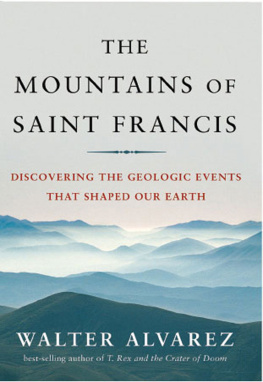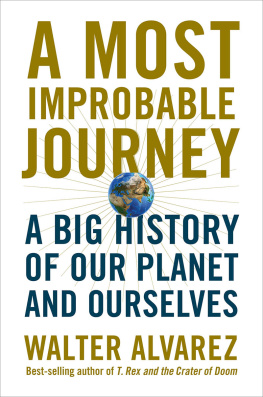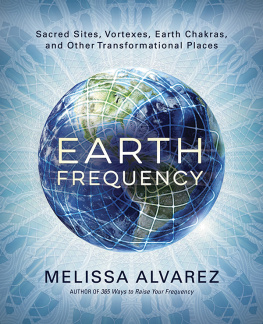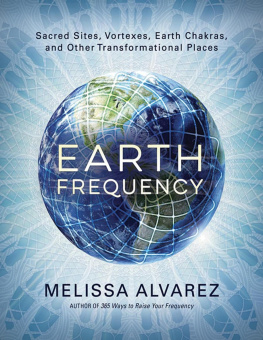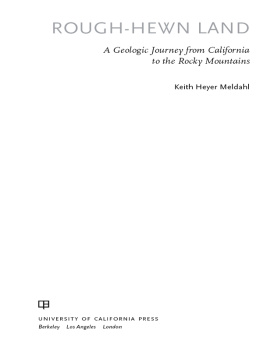W. W. NORTON & COMPANY
W. W. Norton & Company, Inc.
500 Fifth Avenue, New York, N.Y. 10110
www.wwnorton.com
W. W. Norton & Company Ltd.
Castle House, 75/76 Wells Street, London, W1T 3QT
PRELUDE
In which, from a mountaintop, we look out across the landscape of Italy and prepare for a journey into the deep past of the Earth. On that journey we will come to understand how landscapes emerge from the past, and we will explore the great mystery of timethe matrix in which our lives, the history of humanity, and the history of the Earth are embedded.
F ROM HIGH UP on a peak called Monte Nerone, on clear, crisp autumn mornings, you can see far across the landscape of Italy. I often go there while consulting the secret archives of Earth history, written in the rocky outcrops of the Apennine Mountain Range. Stretching all around the horizon, the view carries you back further and further into the past.
To the west range after range of lower mountains recede across Umbria toward sunny Tuscany, where in the 1660s Nicolaus Steno first discovered that the Earth has a history, and learned to read that history in the rocks of the gentle Tuscan hills. Everywhere the scenery tells its own geological storya story that connects with the human past as well.
Around to the south you can make out high, rounded Monte Subasio, where almost five centuries before Steno, Saint Francis of Assisi began a spiritual journey that would profoundly change the world, from his medieval days to our own time.
Off to the east a prominent mountain is slashed through by the wild canyon of Furlo, where seven centuries before Francis, Goths and Byzantines struggled to control a road called the Via Flaminia, built by the ancient Romans.
And along the northern horizon stretches a wilderness of scrambled rock that has glided, mysteriously and imperceptibly, a hundred miles across Italy, hinting at the almost unthinkable wilderness of time that recedes back into our planet's past.
Earth's rocks, like the craggy outcrops on Monte Nerone, bear the record of ancient Earth history. Written in the rocks, though not by a human hand, chronicles of strange and marvelous events await us. In the rock archives we can learn of a huge but painfully slow collision between Italy and Europe that forced up the jagged barrier of the Alps. And we can read of another collision, this one blindingly fast, in which a comet or asteroid struck the Earth, a catastrophe that spelled the end of the dinosaurs. And the archives tell of volcanoes erupting where the city of Rome now stands, and of a time when the Mediterranean Sea evaporated, leaving a vast desert far below sea level.
I have had the great privilege of working for many years in places like Monte Nerone with the Italian geologists, who have uncovered a whole pageant of Earth history. Their annals stretch back hundreds of millions of years, helping us to understand the origin of their beautiful land, and to appreciate the even broader saga of historical evolution through which our entire planet has taken form.
After a day of hard work in the mountains with my Italian friends, we might find ourselves in a little, dimly lit tavern in some medieval village hidden back in a remote canyon of the Apennines, where local wine and pasta would be waiting. After dinner, sitting around the fire, we might tell stories of the adventures and discoveries of our own geology teachers, or our teachers' teachers, and perhaps join in the soft, sweet harmonies of an old Italian song from centuries past. We might take a chilly walk through the ancient heart of town, its narrow streets closed in by stone buildings that still remember the Middle Ages. And sometimes a full moon dancing through gaps in dark clouds would complete the illusion of being transported far back into the remote past.
In a place like this, human history and Earth history seem intimately intermingled. Both are written in stonethe stones that nature has created, and those shaped and set in place by our human ancestors. Most of us have at least some familiarity with the history of humanity, but few people other than geologists find the history of our planet familiar. Yet this kind of history abounds in wonderful stories of worlds that sound like the settings of science fiction or fantasy novels but come from the real past of the Earth. The drama of this planetary history rivals the great episodes in human historythe Roman Empire, the Middle Ages, the Renaissance, the age of exploration, or the two world wars. In this book I hope to make this historical treasure more widely accessibleto bring to life both the historical worlds that geologists have uncovered, and the geologists who have made these discoveries.
It is not easy to tell the story of our planet's past. Earth history is painted on a canvas so multi-textured and complicated, stretching so far back in time, that one must pick and choose what to include, trying to give a broad appreciation and a general flavor, because an encyclopedic account would overwhelm anyone who tried to read or write it. So I have chosen to focus this account of Earth history on one placethe backbone of the Italian Peninsula between Florence and Rome that is officially known as the Umbria-Marche Apennines, although I like to call it "the Mountains of Saint Francis."
Writing about Earth history is also tricky because reading the past recorded in rocks is an arcane skill of little use in everyday life, so therefore is not in the intellectual toolkit of most people. It seems especially foreign because of the immense stretches of time and the almost painfully slow rates of change in the remote past, and this calls for a different viewpoint. Our students at Berkeley enter as freshmen with no more appreciation of geological time and rates of change than anyone else, but after a couple of years of classwork they are fully at home in that arena. I have tried to distill here the concepts and attitudes and information that geology students acquire in a few years and to streamline the process of learning to think comfortably about the deep past.
The mountains, deserts, hills, and valleys of the entire world are the laboratory of the geologist, and they also provide the library in which we read the history of the Earth.1 For those of us fortunate enough to be in this line of work, geology is an exhilarating intellectual adventure, carried out in the open air in the company of good friends. In addition, discovering Earth history is often a true physical adventure as well, for we live and work in remote parts of the world, traveling through wild and challenging country and studying rock outcrops in beautiful and little-known landscapes.
Geologists cannot help meeting the people who live in those places, and getting to know them and their cultures is one of the fringe benefits of our science. If one has a passion for Earth history, it is easy also to become fascinated with the human history of the places where we work. And so in this book I cannot resist setting the geological story of Italy in the context of the people who live there and the human history that lies behind their culture.

